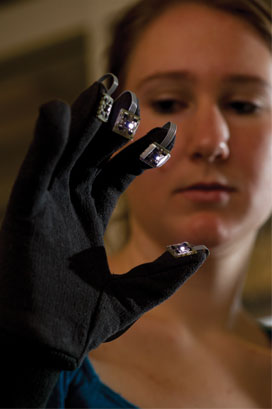Half a century ago, engineers were best known as the designers of bridges, dams, tall buildings, and those newfangled transistor radios. Since then they have been moving into a host of new fields. Meet three Whiting School faculty at the forefront.
Photography by Will Kirk

The Reverse Engineer
Blindfolded, Ralph Etienne-Cummings steps forward, arm out, a single glove on his right hand. The glove has lights and tiny photosensor arrays on its fingertips. It looks like the one Tom Cruise wore in Minority Report. Now Etienne-Cummings reaches out to a sheet of dark blue paper hanging on the wall of his lab. As his luminous touch sweeps over it, the fingertip photosensors soak up the color, activating electromechanical transducers that throb softly against the skin on his forearm. He moves his hand to a sheet of bright red paper, and the throbs become higher-frequency, higher-amplitude buzzings-higher-amplitude meaning brighter, and higher-frequency meaning redder. “With just a little practice, your color recognitions become almost instantaneous,” says Etienne-Cummings.
As director of the Whiting School’s Computational Sensory-Motor Systems Lab, Etienne-Cummings is effectively a reverse engineer of the sensory systems wrought by evolution. The goal of the seeing-eye glove project, for example, is to empower the unsighted to feel their way around their environments in real-world, fine-grained, color-blended detail. “We aim to develop it to the point that a blind person can use it to quickly learn the difference between, say, a box of Cheerios and a box of Frosted Flakes,” he says.
Another set of ongoing projects for Etienne-Cummings aims to give prosthetic limbs much of the dexterity and sensitivity of real limbs. Some of this work has been funded as part of a recent high-profile Pentagon program at Johns Hopkins’ Applied Physics Laboratory, Revolutionizing Prosthetics, which produced an advanced artificial arm now awaiting FDA approval.
Under the program, Etienne-Cummings and his students collaborated with biomedical engineering Professor Nitish Thakor to decode the finger-controlling motor signals normally transmitted down motor nerves in the arm. In an amputee, these motor nerves are severed at the point of amputation. The goal was to hook the severed nerve ends to electrodes, use filtering algorithms to pull the motor signals out of the nervous system “noise,” and then translate those signals into the appropriate servo-motor signals in a prosthetic hand or arm. Etienne-Cummings and his colleagues made plenty of progress-the new arm has a wide range of motions and grips-but they intend to keep pushing the technology forward. “We’d like eventually to get the prosthetic hand working more or less like a real hand, with the ability to dextrously manipulate objects,” Etienne-Cummings says.
True dexterity requires sensory feedback, of course, and the development of that artificial sensory capability has been another major theme in his lab. The signals that would normally send appropriate pressure, texture, temperature, and pain information up the sensory nerves of the arm to the spine and brain no longer exist in a hand or arm amputee. Yet any prosthesis that fails to provide them is going to feel blunt and inanimate.
The technology to produce pressure and temperature signals using miniature transducers in a prosthetic limb already exists. During and since the Pentagon program, Etienne-Cummings and his crew have been working on ways to translate those signals into codes the brain understands-so that the prosthetic arm starts to feel like a real arm.
“We’re trying to understand in detail how this sensory perception works, not just at a neuro-scientific level but at an engineering level so that we can reproduce it,” says Steven Hsiao, a professor in the Krieger School’s Department of Neuroscience, and Etienne-Cummings’ collaborator on this project.
Hsiao has implanted macaque monkeys with electrode arrays, in the area of the brain normally stimulated by pressure-sensitive nerves in the hand. He and his students have been measuring how these neurons normally fire when the monkeys’ hands are stimulated, while Etienne-Cummings and his crew have been working on the development of an electrical stimulator that can appropriately mimic these sensory inputs. “Ralph brings a sophisticated understanding of engineering design, as well as a good fundamental understanding of these neural processes,” says Hsiao. “Together we hope to be able to reproduce, artificially in these monkeys, the sensory feeling of a natural hand-and eventually translate that to the design of a prosthetic hand.”
The artificial arm produced under the Pentagon project is certainly advanced, but Etienne-Cummings is already looking forward to the next generation of prosthetic tech. “For the Pentagon project the goal was to demonstrate some form of close-grip feeling but without really trying to tease out the detailed perceptual neuroscience behind it,” he says. “So there’s still a lot to be done, such as knowing exactly what the coding should be, where in the brain to put the signals, how to make sure that the electrodes are stable-and all those things we’re continuing to work on.”
Cellular Mechanics
Did you ever see that 1966 movie Fantastic Voyage, in which a group of humans and their submarinelike craft are shrunk to micron size and injected into a comatose scientist? Wasn’t it cool how they cruised gently through his arterial system, in search of a deadly blood clot?
Well, Konstantinos Konstantopoulos would like you to know that a person shrunk to the size of a cell and injected into a real artery would have … a somewhat different experience. That micro-miniature person could have only the most fleeting sense of extreme motion, at the scale equivalent of several thousand miles per hour, before being torn to bits by all the buffeting and jostling and general turbulence.
Blood cells are mostly tough enough to take this punishment, but some other cell types that get carried on this screaming ride are not. And even when they do survive, says Konstantopoulos, “what happens to them in this environment is more than mere biochemistry.”




